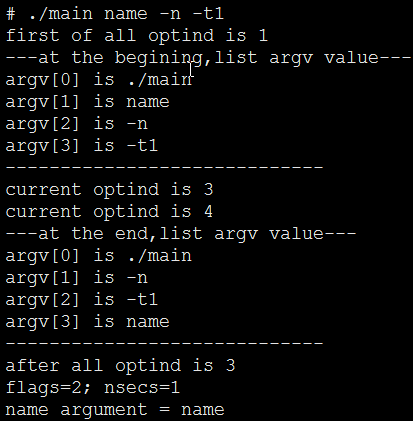By francis_hao Jul 5,2017
getopt:分析命令行选项
概述
#include <unistd.h> |
描述
getopt()函数分析命令行参数,它的参数argc和argv就是程序传递给main()函数的参数,一个以'-'(不是仅有一个'-'或"--")开头的argv元素就是一个选项。'-'后面跟着的就是选项字符,调用多次getopt()函数会连续返回选项字符
变量optind是下一个要处理的元素在argv中的索引,系统初始化该变量为1,调用者可以给它复位为1,以重新扫描argv或扫描一个新的参数向量。
如果getopt()找到一个选项字符,它返回该字符,更新外部变量optind和静态变量nextchar,因此下一次调用getopt()函数时可以继续扫描剩余的选项。如果已经没有更多的选项字符了,getopt()则返回-1,然后,optind变为argv第一个不是选项元素的索引。
optstring是输入参数,它是一个包含需要进行处理的选项字符的集合,如果字符后面跟着一个冒号,表示该选项需要一个参数,因此getopt()将放置一个指向选项后面参数的指针给optarg,注意,形如-t 1和-t1都是可以的,都会将"1"传给optarg。两个冒号说明选项参数是可选的。
默认情况下,getopt()会排列它扫描到的argv中的内容,因此最终,所有不是选项的项会排在最后,另外实现的两种模式:
1、如果optstring的第一个字符是'+',或者环境变量POSIXLY_CORRECT置位,那么getopt()遇到非选项参数即停止,
2、如果optstring的第一个字符是'-',那么每个不是选项的参数,都被当作选项为1的参数处理
命令行中一个特殊的参数"--",当getopt()遇到它时,会强制参数扫描结束。
如果getopt()没有识别选项字符,它会打印一个错误信息到标准错误,存放这个字符到optopt并返回'?'。调用程序可以通过将opterr置0来防止产生错误信息的打印。
关于长选项参见man getopt_long。
示例
本示例为man手册上的例子,添加了一些打印以验证部分描述中的说明。
#include <unistd.h> printf("---at the end,list argv value---
"); |
一个执行实例:

做以下说明:
- optind会指向下一次getopt()函数要处理的argv的索引,最终会指向第一个不是选项的参数的argv中的索引(例中的"name")。
- argv中的参数会被重新排序,不是选项的参数会排在选项参数之后。
- 需要参数的选项,这两种形式是一样的:-t1和-t 1。
程序源码在github上,可以直接clone编译。

本文由 刘英皓 创作,采用 知识共享 署名-非商业性使用-相同方式共享 3.0 中国大陆 许可协议进行许可。欢迎转载,请注明出处:
转载自:http://www.cnblogs.com/yinghao1991/p/7123622.html
参考
【1】 man 3 getopt